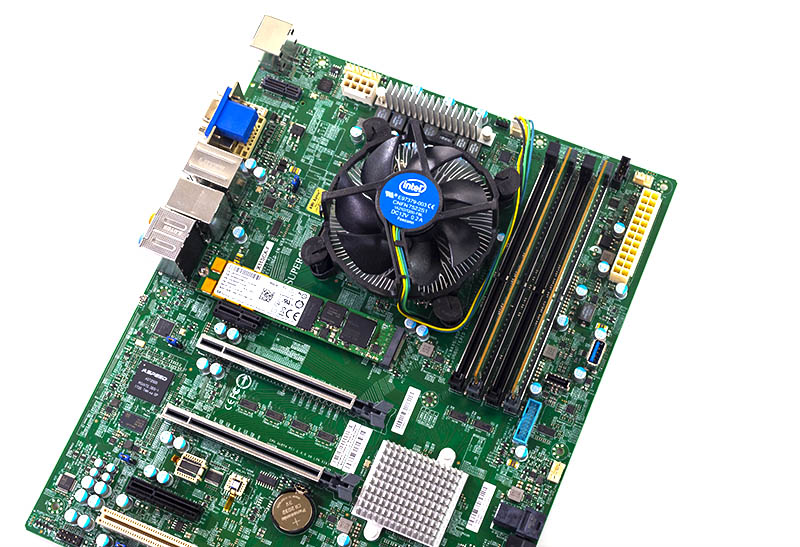Intel Core i3-8300 Power Consumption
We wanted to post a few figures from our testing that show the real selling point of the chips, low power.
Idle is around 32W and maximum power consumption hits just over 89W in our test bed. The solid part about the Intel Core i3-8300 is that it is able to power machines at under 1A in 110V or 120V racks. For the low-cost colocation world, this is a great option.
Note these results were taken using a 208V Schneider Electric / APC PDU at 17.7C and 72% RH. Our testing window shown here had a +/- 0.3C and +/- 2% RH variance.
Intel Core i3-8300 Market Positioning
Thes chips are not released in a vacuum instead, they have competition on both the Intel and AMD sides. When you purchase a server and select a CPU, it is important to see the value of a platform versus its competitors.
Intel Core i3-8300 v. Intel Alternatives
At under $150, and a socketed alternative to the Intel Xeon E-2100 series, we like this CPU. It allows an organization to spec higher-speed and cost parts into the same platforms as higher-end Intel Xeon E-2100 series CPUs, including the impending 8 core/ 16 thread parts. As a drop-in replacement in that ecosystem, we really like this CPU. The fact is that being able to utilize Xeon E-2100 platforms out-of-the-box is a great advantage.

Compared to the Intel Xeon D-2100 series, one gets higher clock speeds that go a long way in mitigating performance disadvantages from losing hyper-threading. At the same time, the Intel Xeon D-2100 series can utilize higher capacity RDIMMs, has more memory bandwidth, and has 10GbE NICs built-in. It is hard to discount that value. The same comparison would likely apply to the Intel Xeon Scalable family where one gets more clock speed with the Intel Core i3-8300 but misses on the platform benefits.
Compared to the Intel Atom C3000 series, the Intel Core i3-8300 does not have all of the same platform features but is much faster in single-threaded workloads. The larger and more robust compute cores and higher frequencies make this an option for sub 120W operation 1U servers.
One feature that the Intel Core i3-8300 has that its Atom and Intel Xeon D siblings do not is the Intel iGPU. The iGPU is not the focus of our CPU benchmark suite, but it includes transcoding hardware support that may be of interest to some deployments with supporting software. One can use BMC graphics for day-to-day management and offload transcoding to dedicated hardware logic not present in mainstream Intel Xeon CPUs outside of the Xeon E-2100 line.
Intel Core i3-8300 v. AMD EPYC
At the time of this writing, AMD EPYC does not have a real competitor to the Intel Core i3-8300 for servers. One can use an AMD Ryzen product and get competitive, if not more compute performance than the Intel Core i3-8300 offers. Until we see platforms like the Tyan Tomcat EX S8015 hit the market, and from multiple vendors, AMD’s superior compute performance with Ryzen is lost by not having platforms with features like IPMI. If someone wanted to use a consumer platform without management, then Ryzen is an option, but the market for that is very small. This is a case where we need to see the ecosystem pick up the slack.
Final Words
Compared to the previous dual-core, quad-thread Intel Core i3 CPUs, we like this direction. The bump to four cores, four threads is being driven by the AMD Ryzen threat on the desktop. That competition has turned an Intel Core i3 server from a significant performance hinderance to a real option in the low-cost server space. We normally review higher-end CPUs, but this is a case where we think the Intel Core i3-8300 is a great value. The CPUs are readily available from shops such as Amazon, which makes them easy to slot into servers today. Unlike the AMD Ryzen platform, there are a number of vendors supporting Core i3 server platforms which means that a user has options for form factors, vendors, and platforms.




Intel going for the low end…
I’ve been watching these closely as well once I discovered the ECC support. These would be stellar for a Plex media server where all the GPU transcoding could be done through the integrated GPU. High clock speeds help to make the server feel snappy too. win/win if I needed to build a new media server.
Unfortunately, my needs involve many docker containers and VMs now. So 8 core+ procs for me. Hoping to see a Xeon-E 8-core CPU in the coming months.
Would be interesting to see the 8300T (low power) and 8350K (higher clock) added to this comparison as well.
Hi, can these run on the C232 based boards such as the Supermicro X11SSL-F-O?
@David J, they’re only compatible with socket 1151-3 so unfortunately only C246 and C242 chipsets are supported
These benchmarks just made me want a 3251 even more to be honest.